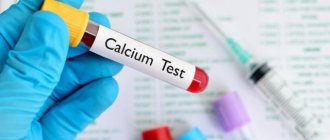This macroelement is responsible for general health, participates in metabolism, bone tissue formation, regulates hormonal balance, ensures proper absorption of nutrients, and normal muscle contractility. Measuring calcium levels is necessary to diagnose dangerous conditions and prevent systemic diseases. Pathologies are indicated by both deficiency and excess of the mineral.
Calcium levels in the body
Blood contains only 1% of the total amount of calcium contained in the body. The rest is concentrated in tissue cells, forming combinations with phosphorus. Plasma is saturated with several forms of the mineral:
- ionized or free calcium (Ca2+), its share: 52–58%;
- associated with protein fractions: up to 38%;
- complexed: composed of salts with bicarbonates, lactates, phosphates and citrates: about 10%.
A normal general level of calcium ensures healthy metabolism, delivery and absorption of other minerals into cells, absorption of vitamins, synthesis of hormones, formation of structures of the skeletal system, teeth, and soft tissues. It is necessary for hematopoiesis, proper functioning of the central nervous system, and maintaining salt metabolism.
The overall level of an essential macronutrient in the body varies depending on age and physical condition. Its general indicators for different categories:
- 1.9–2.6 mmol/l: in newborns;
- 2.25–2.7 mmol/l: in children under 4 years of age;
- 2.1–2.55 mmol/l: in children and adolescents under 18 years of age;
- 2.15–2.5 mmol/l: in adults;
- 2.22–2.55 mmol/l: in elderly people over 65 years of age.
To maintain the normal level of calcium, it must be supplied to the body daily through food. In childhood, the need for the element is about 200 to 1000 mg. Adults need 1200–1400 mg per day. During pregnancy and lactation in women, its dose should be at least 1500 mg. The absorption of the mineral is affected by:
- hormonal background;
- Lifestyle;
- food quality;
- level of phosphorus, magnesium, parathyroid hormone, active form of vitamin D in the body;
- the presence of systemic diseases.
With age, the absorption and content of calcium in the body inevitably decreases. This is caused by a decrease in the activity of the intestines, kidneys, and changes in the endocrine functions of the glands. The mineral is constantly consumed, its salts are excreted through urine and metabolic products, so the development of deficiency is more common than excess. But hypercalcemia is also a likely condition. It occurs due to increased levels of albumin in the blood. This protein provokes the accumulation of bound calcium, which affects its overall level.
Calcium levels in children
What is the normal level of calcium in children's blood?
Normally, total calcium in the blood is:
- In newborns 1.75-3.0 mmol/l;
- In children older than one year, 2.25-2.45 mmol/l;
- In adolescents, 2.15-2.25 mmol/l.
In premature babies at birth, the microelement level may be below 1.25 mmol/l.
In addition, the concentration of ionized calcium in the blood is of great importance, since it is it that is involved in the regulation of various intracellular processes.
The following indicators are considered the norm:
- In children 1.1-1.37 mmol/l;
- In adolescents, 0.98-1.13 mmol/l.
For an adult, the optimal concentration of total Ca2+ in the blood is from 2.10 to 2.55 mmol/l.
How is the normal level of calcium in the blood determined in children?
A blood test can determine the level of this microelement in the body. The material is collected from a vein in the morning on an empty stomach. Before the test, the child can only drink plain still water. If the baby is breastfed, feeding is postponed to later hours.
Preparation for the study is standard and includes following a diet containing light and nutritious foods, eliminating any stress and excessive physical activity on the eve of the procedure. If a child takes any medications, parents are required to notify the doctor who gives the referral for testing.
What is the daily calcium requirement for children?
According to studies, the calcium intake per day for a child should be:
- 500 mg for ages 1 to 2 years;
- 800 mg for ages 4 to 8 years;
- 1300 mg for ages 9 to 18 years.
In addition, for normal absorption and distribution of calcium in the child’s body, an optimal supply of vitamin D, vitamin K, phosphorus, magnesium and other important macro- and microelements is necessary.
Why does your child not get enough calcium?
The causes of Ca2+ deficiency in the body are different and may depend on a combination of a number of factors. Often newborns experience a deficiency of this mineral if the woman did not receive it in the required amount during pregnancy. In older children, a lack of a microelement is most often associated with its insufficient intake from food and water. Some diseases of the endocrine organs and digestive system can aggravate the situation.
Calcium deficiency can be caused by irrational diets, exposure to toxic substances and medications, lack of physical activity, excessive sweating and other reasons. Sometimes a microelement is not absorbed in a child’s body due to a lack of vitamin D or the presence of any disturbances in the process of its metabolism.
In order for your baby to receive enough calcium, it is necessary to include lactic acid products, fatty fish, legumes, some leafy vegetables and nuts in the menu every day. Also, large amounts of the nutrient are found in figs, almonds, amaranth and tofu. Unfortunately, even a properly formulated diet cannot always fully satisfy the needs of a growing body for minerals and vitamins. If the daily calcium requirement for children is not replenished with incoming food and water, doctors recommend taking special medications containing it in sufficient quantities. Preference is given to complex products that contain the most accessible forms of the microelement (calcium citrate or phosphate salts) and other useful active components that improve its absorption in the body.
Indications for analysis
The study of biochemical blood parameters allows you to study in detail the condition of the body, exclude or confirm the development of a number of diseases, adjust the prescribed therapy regimen, and more successfully carry out rehabilitation treatment after surgery. There are two types of calcium testing:
- to the general level;
- for ionized calcium: a highly specialized, expensive, but more informative study.
Calcium testing is indicated for the following conditions:
- muscle weakness;
- frequent numbness of various parts of the body;
- arrhythmic manifestations, other signs of heart disease;
- disruption of the production of hormones of the adrenal glands, thyroid and parathyroid glands, ovaries;
- kidney pathologies;
- intestinal inflammation and malabsorption syndrome;
- oncological diseases;
- decreased albumin levels;
- suspected development of osteoporosis;
- blood clotting disorders;
- symptoms of hypocalcemia: drowsiness, dizziness, deterioration of teeth and nails, hair loss.
A calcium test is recommended before surgery, during the recovery period after complex physical injuries, internal organ transplantation, and blood transfusions.
Why is calcium important?
Calcium is necessary for a child during intrauterine development. If the mother does not consume enough of this element with food, the fetus “takes” it from her bones and teeth. After a baby is born, calcium enters its body from breast milk or formula. In the future, the lack of this macronutrient can be avoided only with the help of a balanced diet.
Calcium is involved in muscle contraction, activates the production of enzymes and hormones, strengthens vascular walls, affects neuromuscular conduction, regulates acid balance and blood pressure. It is also necessary for the formation of bones and teeth, the regulation of blood clotting, and the normal condition of skin and hair. Calcium has, in addition to all of the above, anti-allergic and anti-inflammatory properties.
A lack of this important element in the body can lead to the development of rickets, stunted growth, various pathologies of the cardiovascular system, frequent fractures, poor posture, anemia and other unpleasant consequences. However, for proper absorption, calcium must enter the body together with other substances, in particular phosphorus and vitamin D.
Preparing for testing
A week before the test, it is recommended to refrain from drinking alcohol, potent drugs, vitamin-mineral complexes, fried, smoked and excessively salty foods. Strong coffee, which promotes increased removal of calcium from the plasma, is also not recommended.
It is not advisable to smoke or engage in heavy physical work for 24 hours before the test. Instrumental examinations and infusion procedures are also prohibited. The last meal and drinks should be no later than 12 hours before taking the sample. Then only pure still water is allowed.
Blood should be donated in the morning: optimally from 8 to 12 hours.
Antitumor, anticonvulsant drugs, diuretics, antibiotics and steroid hormones can distort test results. These medications cause a temporary decrease in calcium levels in the body.
Calcium norm for a child per year: pediatrician recommendations
Food contains vitamins and microelements, among which calcium takes pride of place. Next we will talk about its benefits, parents will be able to find out which foods are rich in calcium, and what actions should be taken if there is a lack of calcium in the child’s body. Calcium is one of the vital microelements. Since during the first year of life the baby makes a huge leap in its development, both bone tissue and dentin, as well as tooth enamel, are actively formed. Therefore, it is very important that calcium is an integral part of the diet. Calcium norm in a child's body Many mothers believe that the more calcium in the body, the stronger the baby will be. But this is not true at all. With the huge presence of calcium in the body, it is not absorbed, but is excreted in the urine. You should not overuse supplements and vitamins that contain calcium. The norm is considered to be 500–1000 ml of calcium per day. This is the amount that is absorbed in the body. Pediatricians believe that the normal amount of calcium for a child under one year of age is 600 mg. The daily dose of calcium from birth to 6 months is 400 mg. Parents should know that calcium can be produced in the child’s body independently if the baby is in the sun for 30-60 minutes. Foods rich in calcium The minimum amount of this element is contained in breast milk, and it is absorbed almost completely. Many young mothers do not have the opportunity to breastfeed their baby, so infant formula comes to the rescue. When bottle-fed, babies need foods containing calcium. These are complementary foods, various vegetables and cereals. Calcium is very well absorbed in dairy products such as milk, cheese and cottage cheese. Even if the baby does not eat them for some reason, for example, if he is allergic to dairy products, he will definitely like oatmeal, legumes, dried fruits, nuts, eggs and fish - the best sources of calcium. Lack of calcium in the blood Hypocalcemia is an insufficient amount of calcium. In this condition, there is a delay in the growth and development of the baby, the correct formation of bones and teeth is disrupted, and various types of deformation appear. What should parents be wary of? This is increased neuromuscular excitability or the appearance of seizures. Hair that was previously shiny and silky breaks and falls out. To find out whether a child has enough calcium in his blood, he needs to have his blood tested at a clinic or private laboratory. The main requirement for him is not to eat anything in the morning. We can conclude that children simply cannot do without calcium. This is an important microelement that must be supplied to the body daily through food. Do not forget that calcium is absorbed in the body only with the help of phosphorus, therefore, in order to keep your bones and teeth healthy for many years, you need to eat foods containing phosphorus.
Pediatrician Tambov
What about vitamin D?
The amount of calcium absorbed into our bones depends on the amount of calcium we eat and how much vitamin D we get.
People need vitamin D to help the body absorb calcium. Vitamin D is not found in many foods that children commonly eat. Thus, health professionals often recommend taking it additionally in the form of supplements.
Breastfed babies need vitamin D supplements immediately after birth. Vitamin D has been added to baby foods, so bottle-fed babies generally do not need extra vitamin D.
Ask your doctor if your child needs a vitamin D supplement.
Which vitamin D to choose for a child, I wrote about this here:
How much calcium do your children need?
Calcium is measured in milligrams (mg). We need different amounts at different stages of life. It is best if children get most of their calcium from food. If this is not possible, doctors may recommend a calcium supplement.
It depends on their age, but the American Academy of Pediatrics recommends that children:
Babies
Infants get calcium from breast milk or formula:
- Infants younger than 6 months need 200 mg calcium per day
- Infants 6 to 11 months need 260 mg of calcium per day
Children and teenagers
As children get older, they need more calcium to support bone growth:
- Children 1 to 3 years old need 700 mg calcium per day
- Children 4 to 8 years old need 1000 mg of calcium per day
- Children and adolescents 9 to 18 years old need 1,300 mg of calcium per day
Unfortunately, most children, especially teenagers, get far less than the recommended daily allowance of calcium. This is why it is so important to think about calcium when planning children's meals.
Total calcium
Total calcium
- a predominant microelement, the most important component of bone tissue.
It performs basic structural, metabolic and regulatory functions in the body. Total calcium
is the concentration of the ionized (free) and protein-bound form of calcium. Calcium participates in physiological processes only in ionized form.
General calcium takes part in the construction of the skeleton, heart function, neuromuscular activity, blood clotting and many other processes. Calcium metabolism is closely related to the skeletal system and the functioning of the parathyroid glands. About 99% of calcium is found in bone tissue (teeth, skeletal bones) and only about 1% is found in blood serum and other biological fluids of the body. In bones, calcium is contained in the form of hydroxyapatites - crystals that, in addition to calcium, contain phosphates.
Calcium is found in the blood in three forms:
- ionized (free) calcium, which is physiologically active;
- calcium complexed with anions - lactate, phosphate, bicarbonate, citrate;
- calcium bound to proteins - mainly albumin.
In the body, calcium performs the following functions: creates the basis and ensures the strength of bones and teeth;
participates in the processes of neuromuscular excitability (as an antagonist of potassium ions) and muscle contraction; regulates the permeability of cell membranes; regulates enzymatic activity; participates in the process of blood coagulation (activates VII, IX and X coagulation factors). Calcium homeostasis
Calcium homeostasis (constancy of blood levels) is the result of the balance of the following processes: absorption in the intestines, metabolism in the bones, reabsorption and excretion in the kidneys. These processes are regulated by the main regulators of calcium metabolism: parathyroid hormone and calcitriol (vitamin D3), which increase the level of Ca in the blood, and calcitonin, which reduces its level in the blood, as well as other hormones.
Laboratory signs of calcium metabolism disorders are hypo- and hypercalcemia. A decrease in the level of albumin of any origin (hence, a decrease in the protein-bound fraction of total calcium) causes a decrease in the total concentration of calcium in the blood serum, while the content of biologically active free (ionized) calcium changes little. Therefore, it should be kept in mind that the calcium level in a blood sample may be falsely low if the sample is taken under conditions of local venous stasis. Due to hypoalbuminemia, a decrease in the level of total plasma calcium is observed in cases of protein malabsorption, chronic diseases, a diet with insufficient amounts of protein, liver cirrhosis, and nephrotic syndrome. In such cases, if necessary, they practice determining the content of ionized calcium or using a calculation formula that corrects for the reduced level of blood albumin.
Indications:
- diagnosis and screening of osteoporosis;
- muscle hypotonia;
- convulsive syndrome; paresthesia;
- peptic ulcer of the stomach and duodenum;
- polyuria;
- cardiovascular pathology (arrhythmias and impaired vascular tone);
- preparation for surgery;
- hyperthyroidism;
- malignant neoplasms (lung cancer, breast cancer);
- urolithiasis (X-ray-positive stones) and other kidney diseases;
- bone pain.
Preparation
It is recommended to donate blood in the morning, between 8 am and 12 pm. Blood is drawn on an empty stomach, after 6–8 hours of fasting. It is allowed to drink water without gas and sugar. On the eve of the examination, food overload should be avoided.
Interpretation of results
Units of measurement: mmol/l.
Increased calcium levels (hypercalcemia):
- primary hyperparathyroidism (hyperplasia, adenoma or carcinoma of the parathyroid glands);
- malignant tumors with: a) osteolysis of primary or metastatic bone lesions, especially with metastases of breast, lung, and kidney cancer; b) ectopic synthesis of parathyroid hormone in carcinoma of the kidneys, ovaries, thyroid gland, uterus;
- thyrotoxicosis;
- immobilization hypercalcemia (during immobilization for therapeutic purposes for injuries, Paget's disease, congenital hip dislocation, spinal tuberculosis, etc.);
- hypervitaminosis D;
- adrenal insufficiency;
- hemoblastoses (myeloma, lymphomas, leukemia - with the breakdown of bone tissue in areas of hyperplasia);
- idiopathic hypercalcemia of newborns (Williams syndrome);
- hereditary hypocalciuric hypercalcemia;
- acute renal failure;
- sarcoidosis and other granulomatous diseases;
- iatrogenic hypercalcemia;
- milk-alkali syndrome;
- kidney disease (tertiary hyperparathyroidism);
- overdose of thiazide diuretics.
Low calcium levels (hypocalcemia):
- primary hypoparathyroidism (hereditary, X-linked, DiGeorge syndrome);
- secondary hypoparathyroidism (as a result of surgery, autoimmune);
- hypoparathyroidism in newborns with hyperparathyroidism in the mother;
- hypomagnesemia;
- pseudohypoparathyroidism (hereditary disease caused by a lack of tissue target receptors for parathyroid hormone);
- hypovitaminosis D with rickets in children and osteomalacia in adults (as a result of reduced insolation, malabsorption and nutritional disorders);
- hypoalbuminemia in nephrotic syndrome and liver pathology;
- acute pancreatitis with pancreatic necrosis;
- chronic renal failure;
- liver failure;
- taking antitumor drugs, anticonvulsants, EDTA, neomycin;
- sequestration of calcium ions (acute alkalosis, increased phosphates, transfusion of large amounts of citrated blood).









